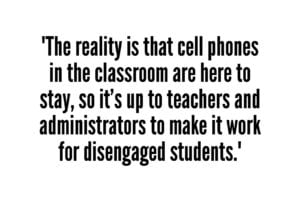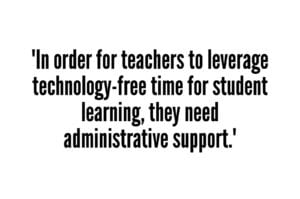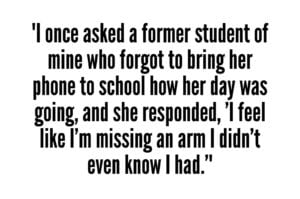This post was originally published in July 2016. In this blog post, former Policy Intern Andrew Shachat reflects on his time as a high school teacher and offers insight into how teachers can creatively engage with struggling students.
If there’s one thing virtually all students are proficient at, it’s cell phone use. Cell phones are increasingly dominating the ways in which students choose to engage with their peers and the digital world around them, consuming nearly nine hours of their day. Amidst the constant call for teachers to adapt classrooms to the 21st century, it’s time we take up the charge on cell phones in classrooms. The reality is that cell phones in the classroom are here to stay, so it’s up to teachers and administrators to make it work for disengaged students.
As a high school teacher at a Title I school, I’ve taught in two types of classrooms. In one classroom, I might be constantly stopping instruction to discipline students distracted by their phones in what feels like a never-ending game of cell phone whack-a-mole. In another classroom, I’m more relaxed as the room fills with a clamor of clicking as students gleefully tap away, engaged in self-paced online review activities differentiated for their own needs. These two classrooms have occurred in the same space, in the same year, with the same students. For teachers seeking ways to engage struggling students, intentionally incorporating cell phone use into lessons provides a great way to enliven the classroom. For this to be effective, however, teachers and administrators must cultivate a classroom culture that facilitates cell phone use with clearly understood intentions, outcomes, and expectations for use.
 The EdTech industry is booming and with it comes unprecedented opportunities to take advantage of students’ propensity for cell phone use. From messaging apps like Kik (which many students use for free unlimited texting) and music streaming services like Tidal to video capture apps like Snapchat and Periscope (which offers a live streaming feed to followers), educators must acknowledge that today’s students are adept at finding and using cell phone apps that satisfy their needs. There is an abundance of ways to cater technology within the classroom to grade level and content, and in doing so, teachers arm themselves with new tools to motivate traditionally disengaged students by meeting them at one of their most relevant strengths: cell phone use. For students (and parents) with busy work or afterschool schedules, apps like Remind keep them up to date on classroom assignments and upcoming deadlines. Websites like Poll Everywhere and Kahoot! shift students’ natural inclination to text towards academic content, overcoming participation issues by blending anonymous student engagement with instant formative assessment. Even students who struggle with chronic absenteeism can stay connected through apps that digitally mix content sharing and organization like Edmodo. With new apps popping up every year to address classroom needs, teachers should increasingly rely on cell phone technology to enhance their instructional practice.
The EdTech industry is booming and with it comes unprecedented opportunities to take advantage of students’ propensity for cell phone use. From messaging apps like Kik (which many students use for free unlimited texting) and music streaming services like Tidal to video capture apps like Snapchat and Periscope (which offers a live streaming feed to followers), educators must acknowledge that today’s students are adept at finding and using cell phone apps that satisfy their needs. There is an abundance of ways to cater technology within the classroom to grade level and content, and in doing so, teachers arm themselves with new tools to motivate traditionally disengaged students by meeting them at one of their most relevant strengths: cell phone use. For students (and parents) with busy work or afterschool schedules, apps like Remind keep them up to date on classroom assignments and upcoming deadlines. Websites like Poll Everywhere and Kahoot! shift students’ natural inclination to text towards academic content, overcoming participation issues by blending anonymous student engagement with instant formative assessment. Even students who struggle with chronic absenteeism can stay connected through apps that digitally mix content sharing and organization like Edmodo. With new apps popping up every year to address classroom needs, teachers should increasingly rely on cell phone technology to enhance their instructional practice.
Beyond logistical hurdles, teachers also need to be prepared to inform students when technology use is not appropriate. Despite the numerous advantages of classroom technology, it is by no means a silver bullet. The wealth of apps can facilitate virtually all aspects of instruction, from content delivery to review to assessment, but sometimes there is just no substitute for a lesson that calls for pencil to paper. Students need adequate time practicing in ways that reflect the means in which they will be assessed, especially considering evidence that students who handwrite their notes learn better. Unless teacher and state assessments switch to models that better reflect blending learning strategies, students need time away from their phones to engage with the material and demonstrate mastery without external technological facilitation. When students use cell phones inappropriately in class for entertainment or other distraction purposes, it is categorically unacceptable and requires teacher action.
The extent to which cell phone policing is effective depends largely on school and district policy. In order for teachers to leverage technology-free time for student learning, they need administrative support. Amongst my colleagues across my district, inappropriate cell phone use repeatedly comes up as one of the most significant barriers to student learning. Clear and consistent consequences for inappropriate cell phone use in classrooms creates well-defined expectations for students to follow. By having an open conversation with students about these consequences and soliciting student input, teachers can increase buy-in for their policy. In schools or districts without a clear or enforceable policy, the varied consequences students receive can cause confusion which can result in increased rates of discipline and loss of instructional time. For many students, their cell phone is the most valuable possession they own. I once asked a former student of mine who forgot to bring her phone to school how her day was going, and she responded, “I feel like I’m missing an arm I didn’t even know I had.” Considering the importance that cell phones play in students’ lives, students sometimes flat out refuse to relinquishing their portal to their digital lives, leading to classroom interruptions and, in rare cases, extreme disruptions. All too many times I’ve talked to teachers who felt unsupported by their administration on disciplining cell phone use, and as a result, have let students stay disengaged on their phones and fall behind in instruction because “it wasn’t worth the fight.” This mindset, which I myself have been guilty of in the past, is detrimental to increasing student achievement and highlights the importance of clear, effective and enforced administrative cell phone policy.
phone policing is effective depends largely on school and district policy. In order for teachers to leverage technology-free time for student learning, they need administrative support. Amongst my colleagues across my district, inappropriate cell phone use repeatedly comes up as one of the most significant barriers to student learning. Clear and consistent consequences for inappropriate cell phone use in classrooms creates well-defined expectations for students to follow. By having an open conversation with students about these consequences and soliciting student input, teachers can increase buy-in for their policy. In schools or districts without a clear or enforceable policy, the varied consequences students receive can cause confusion which can result in increased rates of discipline and loss of instructional time. For many students, their cell phone is the most valuable possession they own. I once asked a former student of mine who forgot to bring her phone to school how her day was going, and she responded, “I feel like I’m missing an arm I didn’t even know I had.” Considering the importance that cell phones play in students’ lives, students sometimes flat out refuse to relinquishing their portal to their digital lives, leading to classroom interruptions and, in rare cases, extreme disruptions. All too many times I’ve talked to teachers who felt unsupported by their administration on disciplining cell phone use, and as a result, have let students stay disengaged on their phones and fall behind in instruction because “it wasn’t worth the fight.” This mindset, which I myself have been guilty of in the past, is detrimental to increasing student achievement and highlights the importance of clear, effective and enforced administrative cell phone policy.
We dream for our students to become future leaders equipped to take on unpredictable challenges in an increasingly technology-driven world. Intentional cell phone use in the classroom allows disengaged students to leverage already existing strengths towards mastering content and overcoming other barriers to learning. Beyond the classroom, administrators must be willing and prepared to support the challenges teachers will inevitably encounter as they use their professional judgment in determining the appropriateness of when and how to use cell phone technology. For teachers fighting insurmountable odds to bring disengaged students back on track, effective cell phone use might mean the difference between a student learning chemistry or learning which Pokémon are hiding under the projector.
Andrew Shachat is a 2016 Policy Intern at the American Youth Policy Forum.





